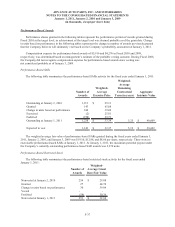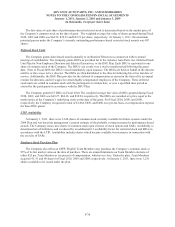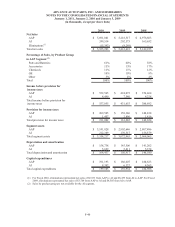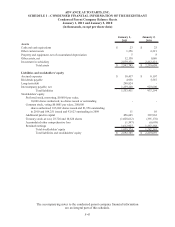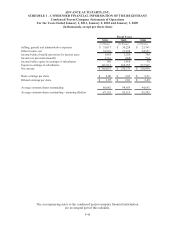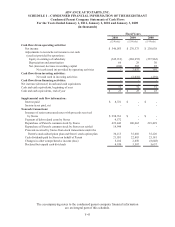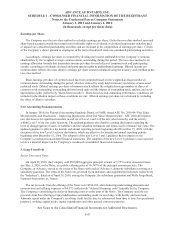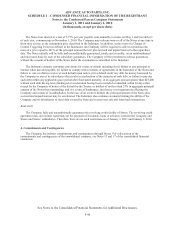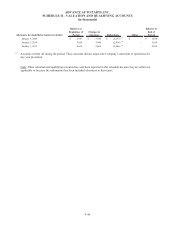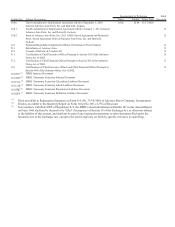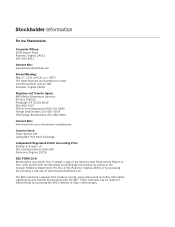Advance Auto Parts 2010 Annual Report Download - page 101
Download and view the complete annual report
Please find page 101 of the 2010 Advance Auto Parts annual report below. You can navigate through the pages in the report by either clicking on the pages listed below, or by using the keyword search tool below to find specific information within the annual report.ADVANCE AUTO PARTS, INC.
SCHEDULE I – CONDENSED FINANCIAL INFORMATION OF THE REGISTRANT
Notes to the Condensed Parent Company Statements
January 1, 2011 and January 2, 2010
(in thousands, except per share data)
See Notes to the Consolidated Financial Statements for Additional Disclosures.
F-47
Earnings per Share
The Company uses the two-class method to calculate earnings per share. Under the two-class method, unvested
share-based payment awards that contain non-forfeitable rights to dividends or dividend equivalents (whether paid
or unpaid) are considered participating securities and are included in the computation of earnings per share. Certain
of the Company’s shares granted to employees in the form of restricted stock are considered participating securities.
Accordingly, earnings per share is computed by dividing net income attributable to the Company’s common
shareholders by the weighted-average common shares outstanding during the period. The two-class method is an
earnings allocation formula that determines income per share for each class of common stock and participating
security according to dividends declared and participation rights in undistributed earnings. Diluted income per
common share reflects the more dilutive earnings per share amount calculated using the treasury stock method or the
two-class method.
Basic earnings per share of common stock has been computed based on the weighted-average number of
common shares outstanding during the period, which is reduced by stock held in treasury and shares of nonvested
restricted stock. Diluted earnings per share of common stock reflects the weighted-average number of shares of
common stock outstanding, outstanding deferred stock units and the impact of outstanding stock options, and stock
appreciation rights (collectively “share-based awards”). Share-based awards containing performance conditions are
included in the dilution impact as those conditions are met. Diluted earnings per share are calculated by including
the effect of dilutive securities.
New Accounting Pronouncements
In January 2010, the Financial Accounting Standards Board, or FASB, issued ASU No. 2010-06 “Fair Value
Measurements and Disclosures – Improving Disclosures about Fair Value Measurements”. ASU 2010-06 requires
new disclosures for significant transfers in and out of Level 1 and 2 of the fair value hierarchy and the activity
within Level 3 of the fair value hierarchy. The updated guidance also clarifies existing disclosures regarding the
level of disaggregation of assets or liabilities and the valuation techniques and inputs used to measure fair value. The
updated guidance is effective for interim and annual reporting periods beginning after December 15, 2009, with the
exception of the new Level 3 activity disclosures, which are effective for interim and annual reporting periods
beginning after December 15, 2010. The adoption of the new Level 1 and 2 guidance had no impact on the
Company’s condensed consolidated financial statements. The adoption of the new Level 3 guidance is not expected
to have a material impact on the Company’s condensed consolidated financial statements.
3. Long-Term Debt
Senior Unsecured Notes
On April 29, 2010, the Company sold $300,000 aggregate principal amount of 5.75% senior unsecured notes
due May 1, 2020, or the Notes, at a public offering price of 99.587% of the principal amount per note. The
Company, or Advance, served as the issuer of the Notes with each of Advance’s domestic subsidiaries serving as a
subsidiary guarantor. The terms of the Notes are governed by an indenture and supplemental indenture (collectively
the “Indenture”), dated as of April 29, 2010, among the Company, the subsidiary guarantors and Wells Fargo Bank,
National Association, as Trustee.
The net proceeds from the offering of the Notes were $294,189, after deducting underwriting discounts and
commissions and offering expenses of $4,572 (collectively “deferred financing costs”) payable by the Company.
The Company is amortizing the deferred financing costs over the term of the Notes. The Company used the net
proceeds from this offering to repay indebtedness outstanding under its revolving credit facility and term loan.
Amounts repaid under the Company’s revolving credit facility may be reborrowed from time to time for operational
purposes, working capital needs, capital expenditures and other general corporate purposes.


